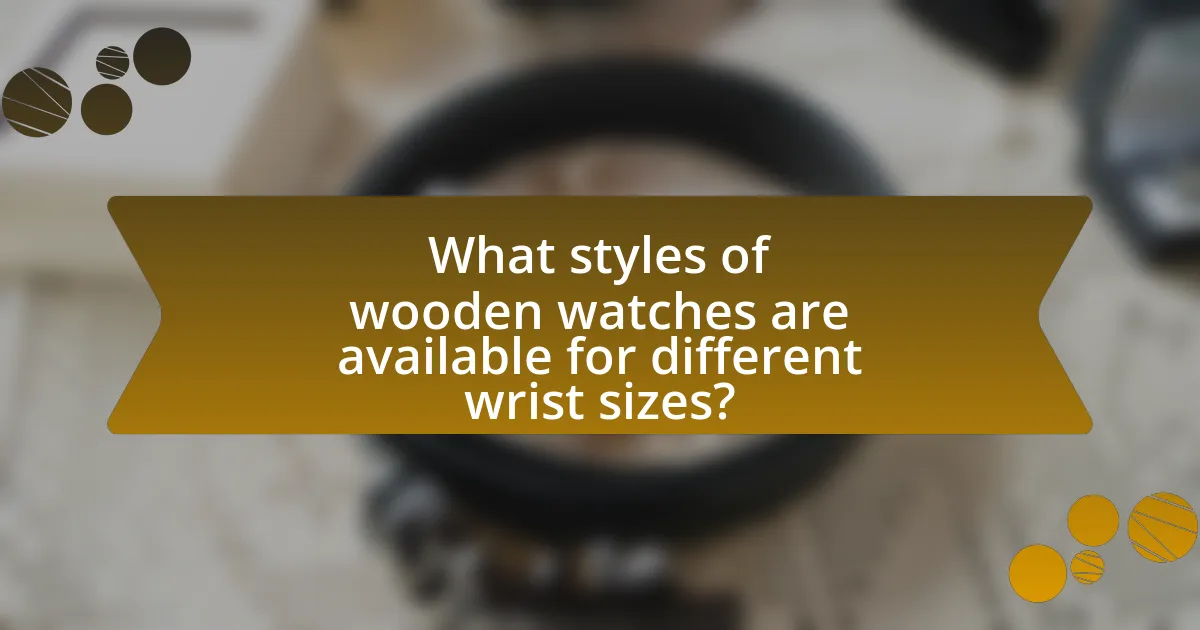The main entity of the article is the wooden watch, which requires specific care and maintenance to ensure its longevity. Key practices for preserving wooden watches include regular cleaning with a soft cloth, controlling humidity levels, and avoiding exposure to extreme temperatures and moisture. The article outlines essential maintenance routines, such as oiling the wood every 3 to 6 months and using safe cleaning materials. It also addresses common issues faced by wooden watch owners, including moisture damage and scratches, and provides troubleshooting tips for minor repairs. Overall, the article serves as a comprehensive guide to effectively caring for wooden watches to maintain their appearance and functionality over time.

How can you effectively care for your wooden watch?
To effectively care for your wooden watch, regularly clean it with a soft, dry cloth to remove dust and moisture. This practice prevents buildup that can damage the wood and finish. Additionally, avoid exposing the watch to extreme temperatures and humidity, as these conditions can warp or crack the wood. Using a wood conditioner periodically can also help maintain its luster and protect against drying out. These methods are essential for preserving the integrity and appearance of the wooden watch over time.
What are the essential maintenance practices for wooden watches?
Essential maintenance practices for wooden watches include regular cleaning, proper storage, and humidity control. Cleaning should be done with a soft, dry cloth to remove dust and moisture, preventing damage to the wood. Proper storage involves keeping the watch in a cool, dry place away from direct sunlight, which can cause fading and warping. Additionally, maintaining humidity levels between 40-60% helps prevent the wood from cracking or splitting. These practices ensure the longevity and functionality of wooden watches, as wood is sensitive to environmental changes.
How often should you clean your wooden watch?
You should clean your wooden watch every few months to maintain its appearance and longevity. Regular cleaning helps remove dirt, oils, and moisture that can damage the wood over time. It is advisable to use a soft, dry cloth for routine maintenance and a slightly damp cloth with mild soap for deeper cleaning, ensuring the watch is dried immediately afterward to prevent water damage.
What cleaning materials are safe for wooden watches?
Cleaning materials that are safe for wooden watches include a soft, lint-free cloth, mild soap mixed with water, and natural oils like jojoba or coconut oil. These materials effectively clean the surface without damaging the wood or finish. For instance, using a damp cloth can remove dust and dirt, while a mixture of mild soap and water can help with more stubborn stains. Natural oils can be applied sparingly to maintain the wood’s luster and protect it from drying out. Avoid harsh chemicals, alcohol, or abrasive materials, as they can harm the wood and its protective coatings.
Why is humidity control important for wooden watches?
Humidity control is important for wooden watches because excessive moisture can lead to wood warping, swelling, or cracking, which compromises the watch’s structural integrity and aesthetic appeal. Wood is a natural material that absorbs and releases moisture based on environmental conditions; therefore, maintaining a stable humidity level prevents these damaging effects. Studies have shown that wood can expand by up to 10% in high humidity, which can disrupt the watch’s movement and functionality. Proper humidity control ensures the longevity and performance of wooden watches by preserving their shape and finish.
How does humidity affect the wood in your watch?
Humidity can cause wood in your watch to expand or contract, leading to potential damage. When exposed to high humidity, wood absorbs moisture, which can result in swelling, warping, or cracking. Conversely, low humidity can cause the wood to dry out, leading to shrinkage and potential gaps in the watch’s structure. Studies indicate that wood’s moisture content can fluctuate significantly with changes in humidity, affecting its physical properties and durability. Therefore, maintaining a stable humidity level is crucial for preserving the integrity and longevity of wooden watches.
What are the best ways to regulate humidity around your watch?
The best ways to regulate humidity around your watch include using silica gel packets, maintaining a stable environment, and avoiding exposure to moisture. Silica gel packets absorb excess moisture, effectively reducing humidity levels in the vicinity of the watch. Maintaining a stable environment involves keeping the watch in a controlled climate, ideally between 30% to 50% humidity, which is optimal for wooden materials. Additionally, avoiding exposure to moisture, such as not wearing the watch in the rain or during activities that may cause sweating, helps prevent humidity-related damage. These methods are essential for preserving the integrity and longevity of wooden watches.
What role does oiling play in maintaining a wooden watch?
Oiling plays a crucial role in maintaining a wooden watch by preventing the wood from drying out and cracking. Regular application of oil helps to nourish the wood, enhancing its natural beauty and ensuring its durability. Additionally, oiling creates a protective barrier against moisture and environmental factors that can lead to deterioration. This practice is supported by the fact that untreated wood can absorb humidity, leading to warping or splitting, while properly oiled wood retains its structural integrity and appearance over time.
How often should you oil your wooden watch?
You should oil your wooden watch every 3 to 6 months. Regular oiling helps maintain the wood’s natural luster and prevents it from drying out or cracking. This timeframe is based on the absorption rate of the wood and environmental factors such as humidity and temperature, which can affect the wood’s condition. Proper maintenance, including oiling, can significantly extend the lifespan of the watch.
What type of oil is best for wooden watches?
The best type of oil for wooden watches is mineral oil. Mineral oil is effective because it penetrates the wood, providing moisture and protection against drying and cracking. Additionally, it does not alter the color of the wood, maintaining the watch’s aesthetic appeal. This oil is commonly used in woodworking and watchmaking due to its non-toxic nature and ability to create a protective barrier against environmental factors.

What precautions should you take to protect your wooden watch?
To protect your wooden watch, avoid exposing it to extreme temperatures and humidity. Wood is sensitive to environmental changes, which can cause warping or cracking. Additionally, keep the watch away from water and chemicals, as moisture can damage the wood and the internal mechanisms. Regularly apply a natural wood conditioner to maintain its finish and prevent drying out. These precautions are essential because wood can absorb moisture and chemicals, leading to deterioration over time.
How can you prevent scratches and damage to your wooden watch?
To prevent scratches and damage to your wooden watch, regularly apply a protective wood conditioner or oil specifically designed for wooden accessories. This treatment not only enhances the wood’s natural beauty but also creates a barrier against moisture and dirt, which can lead to scratches and deterioration. Additionally, storing the watch in a soft pouch or a dedicated watch box when not in use minimizes exposure to potential scratching surfaces. Research indicates that maintaining a consistent care routine significantly extends the lifespan of wooden items, reinforcing the importance of these protective measures.
What are the best storage practices for wooden watches?
The best storage practices for wooden watches include keeping them in a cool, dry place away from direct sunlight and humidity. Wooden watches are sensitive to temperature and moisture, which can cause warping or cracking. Storing them in a dedicated watch box or a soft pouch can protect them from dust and scratches. Additionally, using silica gel packets can help absorb excess moisture in the storage environment, further preserving the integrity of the wood.
How can you avoid exposure to extreme temperatures?
To avoid exposure to extreme temperatures, keep your wooden watch in a climate-controlled environment, ideally between 60°F and 80°F (15°C to 27°C). Extreme heat can cause the wood to warp or crack, while extreme cold can lead to brittleness. Storing the watch in a protective case away from direct sunlight and heating sources, as well as avoiding wearing it during extreme weather conditions, further minimizes temperature-related damage.
Why is it important to avoid water exposure for wooden watches?
Avoiding water exposure for wooden watches is crucial because water can cause the wood to swell, warp, or crack. Wood is a porous material, and when it absorbs moisture, it compromises the structural integrity and aesthetic appearance of the watch. Additionally, prolonged exposure to water can lead to mold and mildew growth, further damaging the watch. This information is supported by the fact that many wooden watch manufacturers explicitly recommend keeping their products away from water to maintain their quality and longevity.
What should you do if your wooden watch gets wet?
If your wooden watch gets wet, immediately dry it with a soft, absorbent cloth to remove excess moisture. Prolonged exposure to water can cause the wood to warp or crack, compromising the watch’s integrity. It is essential to avoid using heat sources like hair dryers, as they can further damage the wood. Additionally, allow the watch to air dry in a cool, dry place, ensuring it is not exposed to direct sunlight, which can lead to fading or additional warping. Regular maintenance, such as applying a wood conditioner, can help protect the watch from moisture damage in the future.
How can you waterproof your wooden watch effectively?
To waterproof your wooden watch effectively, apply a high-quality wood sealant or waterproofing oil specifically designed for wood. These products penetrate the wood fibers, creating a barrier against moisture while preserving the watch’s natural appearance. For instance, products containing tung oil or linseed oil are known for their water-resistant properties and can enhance the durability of wooden items. Regular application, typically every six months, ensures ongoing protection against water damage, which is crucial for maintaining the watch’s longevity.

What are the common issues faced by wooden watch owners?
Wooden watch owners commonly face issues such as susceptibility to moisture damage, scratches, and fading of the wood finish. Moisture can cause the wood to swell or warp, leading to functional problems. Scratches can occur easily due to the softer nature of wood compared to metal, affecting the watch’s aesthetic appeal. Additionally, exposure to sunlight can result in fading, diminishing the watch’s original color and luster. These issues highlight the need for proper care and maintenance to ensure the longevity of wooden watches.
What signs indicate that your wooden watch needs repair?
Signs that indicate your wooden watch needs repair include visible cracks or splits in the wood, which compromise its structural integrity. Additionally, if the watch is not keeping accurate time, it may signal a mechanical issue that requires attention. Another sign is the presence of water damage, such as swelling or discoloration, which can occur if the watch is exposed to moisture. Lastly, if the watch band shows significant wear or damage, it may need replacement to ensure proper functionality and comfort.
How can you identify wood warping or cracking?
To identify wood warping or cracking, examine the wood for visible distortions or irregularities in shape. Warping typically manifests as bending or twisting of the wood, while cracking appears as fissures or splits on the surface. Additionally, check for gaps between joints or components, which can indicate structural issues. Regular inspection is crucial, as early detection can prevent further damage.
What should you do if the watch mechanism is malfunctioning?
If the watch mechanism is malfunctioning, you should take it to a professional watchmaker or authorized service center for repair. Professional technicians possess the expertise and tools necessary to diagnose and fix intricate issues within the watch mechanism, ensuring that it operates correctly. Attempting to repair the watch yourself can lead to further damage, as watch mechanisms are delicate and require specialized knowledge for proper handling.
How can you troubleshoot common problems with wooden watches?
To troubleshoot common problems with wooden watches, first identify the specific issue, such as moisture damage, scratches, or a malfunctioning movement. For moisture damage, ensure the watch is dried immediately and avoid exposing it to water. If scratches occur, use a fine sandpaper or a wood polish to gently buff the affected area. For movement issues, check the battery if applicable, or consult a professional watchmaker for repairs. These methods are effective as they directly address the common issues faced by wooden watches, ensuring their longevity and functionality.
What are the best practices for fixing minor scratches?
To fix minor scratches on a wooden watch, use a soft cloth and a small amount of wood polish or mineral oil to gently buff the scratched area. This method helps to restore the wood’s natural luster and can minimize the appearance of scratches. Additionally, for deeper scratches, fine-grit sandpaper can be used lightly to smooth the surface, followed by reapplying wood polish to protect the area. These practices are effective because they utilize materials that are safe for wood and help maintain the watch’s finish, ensuring its longevity.
How can you restore the finish of a worn wooden watch?
To restore the finish of a worn wooden watch, clean the surface with a soft cloth and a mild soap solution to remove dirt and oils. After cleaning, apply a wood conditioner or a specialized wood finish product designed for watches, using a soft cloth to ensure even coverage. Allow the product to penetrate and dry according to the manufacturer’s instructions. This method is effective because wood finishes protect the wood from moisture and wear, enhancing its appearance and longevity. Regular maintenance, including reapplication of the finish as needed, can help preserve the watch’s aesthetic and structural integrity.
What are the best tips for ensuring the longevity of your wooden watch?
To ensure the longevity of your wooden watch, regularly clean it with a soft, dry cloth to remove dust and moisture. This practice prevents buildup that can damage the wood over time. Additionally, avoid exposing the watch to extreme temperatures and humidity, as these conditions can warp or crack the wood. It is also advisable to apply a wood conditioner periodically to maintain its finish and protect against wear. Lastly, store the watch in a cool, dry place when not in use to further safeguard its integrity.






































